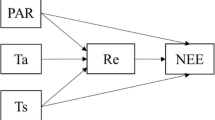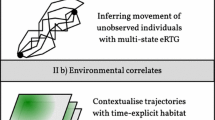Abstract
Studies of animal movements have been popularized for many large and shy species by the increasing use of radio telemetry methods (VHF and GPS technologies). Data are collected with high sampling frequency, and consist of successive observations of the position of an individual animal. The statistical analysis of such data poses several problems due to the lack of independence of successive observations. However, the statistical description of the temporal autocorrelation between successive steps is rarely performed by ecologists studying the patterns of animals movements. The aim of this paper is to warn ecologists against the consequences of failing to consider this aspect. We discuss the various issues related to analyzing autocorrelated data, and show how the exploratory analysis of autocorrelation can both reveal important biological insights and help to improve the accuracy of movement models. We suggest some tools that can be used to measure, test, and adjust for temporal autocorrelation. A short ecological illustration is presented.



Similar content being viewed by others
References
Aschoff J (1966) Circadian activity pattern with two peaks. Ecology 47:657–662
Austin D, Bowen W, McMillan J (2004) Intraspecific variation in movement patterns: modeling individual behaviour in a large marine predator. Oikos 105:15–30
Bailey H, Thompson P (2006) Quantitative analysis of the bottlenose dolphin movement patterns and their relationship with foraging. J Anim Ecol 75:456–465
Banks J, Yasenak C (2003) Effects of plot vegetation diversity and spatial scale on Coccinella septempunctata movement in the absence of prey. Entomol Exp Appl 108:197–204
Bergman C, Schaeffer J, Luttich S (2000) Caribou movement as a correlated random walk. Oecologia 123:364–374
Bourgoin G, Garel M, Dubray D, Maillard D, Gaillard J (2009) What determines global positioning system fix success when monitoring free-ranging mouflon? Eur J Wildl Res 55:603–613
Bowne D, Peles J, Barrett G (1999) Effects of landscape spatial structure on movement patterns of the hispid cotton rat (Sigmodon hispidus). Landsc Ecol 14:53–65
Brillinger D, Preisler H, Ager A, Kie J (2004) An exploratory data analysis (EDA) of the paths of moving animals. J Stat Plan Infer 122:43–63
Cain M (1989) The analysis of angular data in ecological field studies. Ecology 70:1540–1543
Cain M, Carson W, Root R (1991) Long-term suppression of insect herbivores increases the production and growth of Solidago atissima rhizomes. Oecologia 88:251–257
Calenge C (2006) The package “adehabitat” for the R software: a tool for the analysis of space and habitat use by animals. Ecol Model 197:516–519
Calenge C, Dray S, Royer-Carenzi M (2009) The concept of animals trajectories from a data analysis perspective. Ecol Inform 4:34–41
Cardona L, Revelles M, Carreras C, San Félix M, Gazo M, Aguilar A (2005) Western Mediterranean immature loggerhead turtles: habitat use in spring and summer assessed through satellite tracking and aerial surveys. Mar Biol 147:583–591
De Solla S, Bonduriansky R, Brooks R (1999) Eliminating autocorrelation reduces biological relevance of home range estimates. J Anim Ecol 68:221–234
Diggle P (1990) Time series: a biostatistical introduction. Oxford University Press, Oxford
Dray S, Legendre P, Peres-Neto P (2006) Spatial modeling: a comprehensive framework for principal coordinate analysis of neighbor matrices (PCNM). Ecol Model 196:483–493
Dumont C, Himmelman J, Robinson S (2007) Random movement pattern of the sea urchin Strongylocentrotus droebachiensis. J Exp Mar Biol Ecol 340:80–89
Dunn J, Gipson P (1977) Analysis of radio telemetry data in studies of home range. Biometrics 33:85–101
Firle S, Bommarco R, Ekbom B, Natiello M (1998) The influence of movement and resting behavior on the range of three carabid beetles. Ecology 79:2113–2122
Fisher N (1996) Statistical analysis of circular data. Cambridge University Press, Cambridge
Fortin D, Morales J, Boyce MS (2005) Elk winter foraging at fine scale in Yellowstone National Park. Oecologia 145:335–346
Frair J, Nielsen SE, Merrill E, Lele S, Boyce MS, Munro R, Stenhouse G, Beyer H (2004) Removing GPS collar bias in habitat selection studies. J Appl Ecol 41:201–212
Frair J, Merrill E, Visscher D, Fortin D, Beyer H, Morales J (2005) Scales of movement by elk (Cervus elaphus) in response to heterogeneity in forage resources and predation risk. Landsc Ecol 20:273–287
Graves T, Waller J (2006) Understanding the causes of missed global positioning system telemetry fixes. J Wildl Manag 70:844–851
Griffith DA, Peres-Neto P (2006) Spatial modeling in ecology: the flexibility of eigenfunction spatial analyses. Ecology 87:2603–2613
Jammalamadaka S, Sengupta A (2001) Topics in circular statistics. World Scientific Press, Singapore
Jupp P, Mardia K (1980) A general correlation coefficient for directional data and related regression problems. Biometrika 67:163–173
Kareiva P, Shigesada N (1983) Analyzing insect movement as a correlated random walk. Oecologia 56:234–238
Lancaster J, Buffin-Bélanger T, Reid I, Rice S (2006) Flow- and substratum-mediated movement by a stream insect. Freshw Biol 51:1053–1069
Legendre P (1993) Spatial autocorrelation: trouble or new paradigm? Ecology 74:1659–1673
Legendre P, Legendre L (1998) Numerical ecology, 2nd edn. Elsevier, Amsterdam
Lorch P, Sword G, Gwynne D, Anderson G (2005) Radiotelemetry reveals differences in individual movement patterns between outbreak and non-outbreak Mormon cricket populations. Ecol Entomol 30:548–555
Marsh L, Jones R (1988) The form and consequences of random walk movement models. J Theor Biol 133:113–131
Martin J, Calenge C, Quenette P, Allainé D (2008) Importance of movement constraints in habitat selection studies. Ecol Model 213:257–262
McCulloch C, Cain M (1989) Analyzing discrete movement data as a correlated random walk. Ecology 70:383–388
Morales J, Ellner S (2002) Scaling up animal movements in heterogeneous landscapes: the importance of behavior. Ecology 83:2240–2247
Nathan R, Getz W, Revilla E, Holyoak M, Kadmon R, Saltz D, Smouse P (2008) A movement ecology paradigm for unifying organismal movement research. Proc Natl Acad Sci 105:19052–19059
Nolet B, Mooij W (2002) Search paths of swans foraging on spatially autocorrelated tubers. J Anim Ecol 71:451–462
Odendaal F, Turchin P, Stermitz F (1989) Influence of host-plant density and male harassment on the distribution of female Euphydras anicia (Nymphalidae). Oecologia 78:283–288
Parks E, Derocher A, Lunn N (2006) Seasonal and annual movement patterns of polar bears on the sea ice of Hudson Bay. Can J Zool 84:1281–1294
Patterson T, Thomas L, Wilcox C, Ovaskainen O, Matthiopoulos J (2008) State-space models of individual animal movement. Trends Ecol Evol 23:87–94
Peres-Neto P (2006) A unified strategy for estimating and controlling spatial, temporal and phylogenetic autocorrelation in ecological models. Oecol Bras 10:105–119
Preisler H, Ager A, Johnson B, Kie J (2004) Modeling animal movements using stochastic differential equations. Environmetrics 15:643–657
Revilla E, Wiegand T, Palomares F, Ferreras P, Delibes M (2004) Effects of matrix heterogeneity on animal dispersal: from individual behavior to metapopulation-level parameters. Am Nat 164:130–153
Root R, Kareiva P (1984) The search of resources by cabbage butterflies (Pieris rapae): ecological consequences and adaptive significance of Markovian movements in a patchy environment. Ecology 65:147–165
Schaeffer J, Messier F (1997) Footedness in foraging muskoxen Ovibos moschatus. Acta Theriol 42:335–338
Schick R, Loarie S, Colchero F, Best B, Boustany A, Conde D, Halpin P, Joppa L, McClellan C, Clark J (2008) Understanding movement data and movement processes: current and emerging directions. Ecol Lett 11:1338–1350
Siniff D, Jessen C (1969) A simulation model of animal movement patterns. Adv Ecol Res 6:185–219
Solow AR (1990) A note on the statistical properties of animal locations. J Math Biol 29:189–193
Swihart R, Slade N (1985a) Testing for independence of observations in animal movements. Ecology 66:1176–1184
Swihart RK, Slade NA (1985b) Influence of sampling interval on estimates of home-range size. J Wild Manage 49:1019–1025
Tukey J (1977) Exploratory data analysis. Addison-Wesley, Reading
Tukey J (1980) We need both exploratory and confirmatory. Am Stat 34:23–25
Turchin P (1998) Quantitative analysis of movement: measuring and modeling population redistribution in plants and animals. Sinauer Associates, Sunderland
von Neumann J (1941) Distribution of the ratio of the mean square successive difference to the variance. Ann Math Stat 12:367–395
von Neumann J, Kent R, Bellinson HR, Hart B (1941) The mean square successive difference. Ann Math Stat 12:153–162
Wald A, Wolfowitz J (1943) An exact test for randomness in the non-parametric case based on serial correlation. Ann Math Stat 14:378–388
Wittemyer G, Polansky L, Douglas-Hamilton I, Getz W (2008) Disentangling the effects of forage, social rank, and risk on movement autocorrelation of elephants using Fourier and wavelet analyses. Proc Natl Acad Sci 105:19108–19113
Acknowledgments
We are grateful to Jon Swenson and to the Scandinavian Brown Bear Research Project for kindly providing the data. Financial support has been provided by the ANR (project Mobilité ANR-05-BDIV-008) and the ONCFS. We would like to thank Jean-Michel Gaillard, Jodie Martin, and Dominique Allainé for their comments on earlier drafts of this paper.
Author information
Authors and Affiliations
Corresponding author
Electronic supplementary material
Below is the link to the electronic supplementary material.
About this article
Cite this article
Dray, S., Royer-Carenzi, M. & Calenge, C. The exploratory analysis of autocorrelation in animal-movement studies. Ecol Res 25, 673–681 (2010). https://doi.org/10.1007/s11284-010-0701-7
Received:
Accepted:
Published:
Issue Date:
DOI: https://doi.org/10.1007/s11284-010-0701-7




